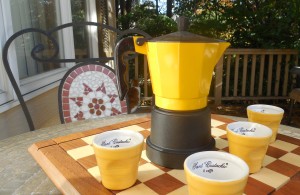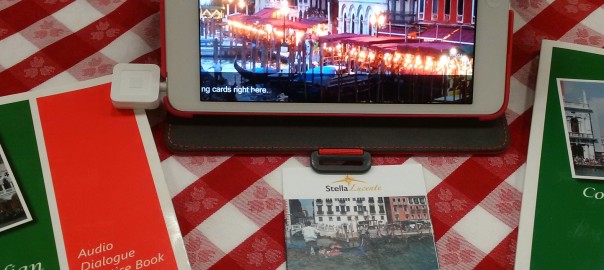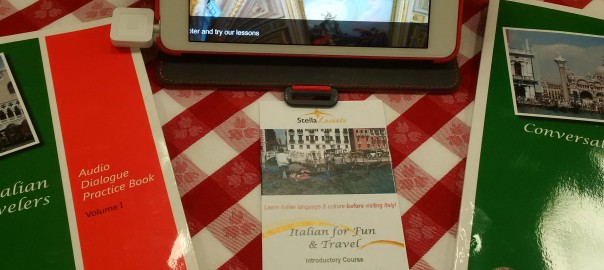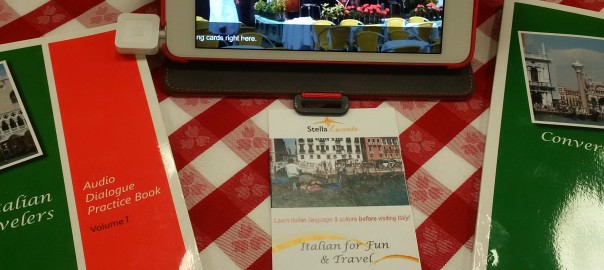 Everything you need to know
Everything you need to know
to talk over the phone about your Italian beach vacation… in Italian!
Can you speak Italian? By now, many of you have passed the beginning stages of learning how to speak Italian and can read and comprehend quite a bit of the language. Meraviglioso!
But have you tried to take the next step to speak Italian fluently? Can you talk about what you did on your Italian beach vacation using the past tense correctly—over the phone?
Can you speak Italian the way you would speak in your native language, with complex and varied sentences? This is more difficult than it may seem at first, and it’s something that I am always working on!
This series will focus on the situations that have come up most frequently in my everyday conversations with Italian instructors and friends. The “Speak Italian” blog series will focus on the type of sentence structure and vocabulary we all need to remember to be more fluent when we speak Italian!
To take that giant step from simple beginning sentences to more complex and fluid sentences in Italian, we must know how to use the present and the past tense easily; in this segment, we will focus on the pronomial verb esserci and the past tense in Italian. We will discuss how to use the helping verbs avere and essere with the passato prossimo past tense, the trapassato past tense, the verb passare in the past tense, and the past progressive tense. At the end will be an introduction to the future tense as well!
If you need to refresh your memory on when to use the passato prossimo form of the past tense versus when to use the imperfetto, please visit the third blog post in this series, Speak Italian: A Story About… Love!
In the “Speak Italian” blog series, a short essay or dialogue in Italian will be presented about a commonly used topic of conversation. Then, we will review the Italian grammar that is necessary to talk about the particular topic in detail. And finally, the same material will be presented in Italian and English, with blanks for the reader to fill in with descriptions from his or her own life or to practice verb conjugation! Remember these examples as “anchors” in your knowledge for when you must speak Italian in your next conversation!
Enjoy the fourth topic in this series, “Speak Italian: Italian Vacation Revisited by Phone”
—Kathryn Occhipinti
This material is adapted from our textbook, Conversational Italian for Travelers © 2012 by Stella Lucente, LLC, found on www.learntravelitalian.com. Special thanks to Italian language instructor Simona Giuggioli.
In the dialogue to follow, we listen in on a conversation between an Italian mother and her daughter after the two have been separated for a few weeks. It turns out that the daughter has been enjoying a vacation on the beaches of Sicily. While reading their conversation, try to pick out the past tense verbs and notice which helping verb—avere or essere—is used for each.
And… by the way, the southern coast of Sicily has beautiful beaches and really is a destination for windsurfing!
Speak Italian: Italian Beach Vacation Revisited
by Phone
Una mattina, mentre Francesca stava preparando la prima colazione per se stessa e suo figlio che si chiama Carlo, i due hanno sentito lo squillo del cellulare.
One morning, while Frances was preparing breakfast for herself and her son Carl, they heard the cell phone ring.
Carlo ha detto, “Rispondo io” e si è diretto verso al soggiorno. Ha preso il cellulare dal tavolino e ha risposto.
Carl said, “I’ll get it (I’ll answer it),” and headed over to the living room. He took the cell phone from the end table and answered (it).
“Pronto,” ha detto lui. “Chi è? Chi parla?” E dopo: “Anna! Come stai? Ti passo mamma.”
“Hello,” he said. “Who is it? Who’s calling (lit. speaking)?” And after, “Anna! How are you? I’ll get (pass the phone to) mom for you.”
Era Anna, la figlia di Francesca, che era appena tornata dalla vacanza in Sicilia!
It was Anna, Frances’s daughter, who had just returned from vacation in Sicily!
Francesca aveva ricevuto qualche messaggio da Anna sul cellulare, ma non si erano parlate a telefono per tre settimane.
Frances had received some texts from Anna on the cell phone, but they had not spoken to each other on the phone for three weeks.
“Quanto tempo è passato!” ha detto Francesca ad Anna, dopo che Carlo le ha passato il cellulare. “Sono molto contenta di sentirti!”
“How much time has gone by!” Frances said to Anna, after Carl gave (passed) her the cell phone. “I am so happy to hear from you!”
“Mamma! Sono solo tre settimane!” ha detto Anna a Francesca.
“Mom! (Up until now it) is only three weeks!”(English: has been only) said Anna to Frances.
“Lo so. Dimmi! Dove sei? Perché non sei tornata a casa? Sei ancora alla stazione? Passerò a prenderti prima del lavoro.”
“I know. Tell me! Where are you? Why haven’t you come home? Are you still at the station? I will pick you up before work.”
“Stai calma, mamma!” ha detto Anna. “Siamo arrivate a Roma ieri sera ma era molto tardi, cosi ho passato la notte a casa di Giulia.”
“Calm down, mom!” Anna said. “We arrived at Rome last night, but it was very late, so I stayed at Julia’s house for the night.”
Anna ha continuato a parlare: “Verrò ad Avezzano in treno e sarò alla stazione alle quattordici. Chi può venire a prendermi alla stazione, tu or Carlo?”
Anna continued (to talk): “I will come to Avezzano by train and will be at the station at 2 p.m. Who can come to pick me up at the station, you or Carl?”
“Questo pomeriggio sarà in ufficio, ma Carlo può portarti a casa in macchina sua.”
“This afternoon I will be at the office, but Carl can take you home in his car.”
“Ci sarò,” ha detto Carlo, che ha sentito la conversazione. “Non preoccuparti!”
“I will be there,” said Carl, who had heard the conversation. “Don’t worry!”
“È papà?” ha chiesto Anna. “Non c’è?”
“And dad?” asked Anna. “Is he (not) there?”
“No. Non c’è a casa questa settimana. È dovuto andare a Milano.”
“No. He’s not at home this week. He had to go to Milan.”
“Dimmi un po’ della tua vacanza. C’era bel tempo? Era bella la spiaggia in Sicilia? E come era l’appartamento della famiglia di Giulia?”
“Tell me a little bit about your vacation. Was the weather nice? Was the beach nice in Sicily? And how was Julia’s family’s apartment?”
“C’era molto sole, naturalmente! Eravamo in Sicilia! La spiaggia era molto bella. Mi piace molto la zona di Ragusa, lo sai. Ti ho mandato molte foto via SMS. Non le hai ricevute?”
“It was very sunny, naturally! We were in Sicily! The beach was very beautiful. I love the area around Ragusa, you know. I texted a lot of photos to you. Didn’t you receive them?”
“Si, le ho ricivute. Ma che hai fatto per tutti quei giorni sulla spiaggia?”
“Yes, I received them. But what did you do for all those days on the beach?”
“Ho preso il sole. Mi sono rilassata molto. Ho nuotato con Giulia e qualche amica che abbiamo incontrato là.”
“I sunbathed. I relaxed a lot. I swam with Julia and some friends that we met there.”
“Li conosco, questi amici?”
“Do I know these friends?”
“Ne conosci solamento uno. Ricordi Giovanni che ho incontrato all’università di Roma?”
“You know only one of them. Do you remember John whom I met at college in Rome?”
“No. Non me lo recordo affatto.”
“No. I really don’t remember him.”
“È un tipo corto ma magro… con i capelli neri. In ogni caso, l’ho incontrato per caso sulla spiaggia. C’erano tre ragazzi vicino a me. Ma Giovanni è passato davanti a me e l’ho riconosciuto.”
“He is the short type but thin… with black hair. In any case, I met him by chance on the beach. There were three guys near me. But John passed by in front of me and I recognized him.”
“L’ho riconosciuto subito, perché lui mi piaceva molto quando eravamo a scuola insieme.”
“I recognized him right away, because I really liked him when we were at school together.”
“Veramente? Non mi hai mai parlato di lui prima.”
“Really? You never talked to me about him before.”
“Allora, ci siamo passati i numeri di telefono e resteremo in contatto d’ora in poi.”
“Anyway, we exchanged telephone numbers and will remain in contact from now on.”
“Va bene! Qual cos’altro è successo?”
“Very well! What else happened?”
“Ho anche camminato molto sulla spiaggia e qualche volta ho corso un po’ sul lungomare dietro dell’appartamento. Una mattina sono corsa al porto di Ragusa per incontrari i miei amici.”
“I also walked a lot on the beach, and several times I ran a bit along the boardwalk in back of the apartment. One morning I ran to the port of Ragusa to meet my friends.”
“Che hai fatto al porto?”
“What did you do at the port?”
“Vicino al porto c’è la spiaggia pubblica. Abbiamo fatto windsurf.”
“Near the port is the public beach. We went windsurfing.”
“Meraviglioso! Lo so che ti piace molto fare windsurf.”
“Great! I know that you really like windsurfing.”
“E uno dei nostri amici ha una barca. Alcune sere siamo restati in barca fino alle nove di sera e abbiamo visti il tramonto sul mare.”
“And one of our friends has a boat. Some nights we stayed in the boat until 9 p.m. and watched the sunset from the sea.”
“Molto bello!”
“Very nice!”
“Un altra sera io e Giulia siamo andate al ristorante a Scicli. Giovanni e un ragazzo che si chiama Paolo ci hanno portato lì. Il ristorante era sottoterra, in una grotta, con le candele accesse sulle tavole. Era molto romantico.”
“Another night Julia and I went to a restaurant in Scicli. John and a guy called Paul took us there. The restaurant was underground, in a grotto, with candles on the tables. It was very romantic.”
“Dopo siamo andati a ballare in un piccolo discoteca vicino. Abbiamo ballato fino alle due di mattina. È stato molto divertente!”
“Afterward, we went to dance in a small club nearby. We danced until 2 a.m. It was a lot of fun!”
“Mi sembra di si!”
“It seems like it was!”
“C’è altro della storia di Giovanni e me. Ma ora ho appena finito un caffè e devo preparmi per uscire di casa. Ci parliamo più tardi.”
“There’s more to the story about John and me. But now I have just finished a cup of coffee, and I have to get ready to go out. We’ll talk more later.”
“Va bene. Ma ci vediamo presto!”
“OK. But we will see each other soon!”
“Si, mamma! La storia dell’estate è finita ma un altra storia sta per comminciare!”
“Yes, Mom! The summertime story is over, but another story is about to begin!”
Speak Italian: You Will Need to Know…
How to Use the Pronomial Verb Esserci
The verb esserci means “to be there,” or “to be around.” Notice that the adverb “ci,” which takes on the meaning of “there,” is an integral part of this verb.
Anyone who has been speaking Italian for even a short time has probably heard the expressions “c’è” for “there is” and “ci sono” for “there are.” These phrases are mentioned in Chapter 6 of our textbook, Conversational Italian for Travelers. Now we know the infinitive verb that the above expressions originate from!
There are many, many expressions that use esserci. Below is a list of the most common expressions. “Ci sarò” for “I will be there!” comes up often in conversation. “Sarò là,” or “Sara lì,” are two equivalent phrases that may be heard today that use the verb essere instead of esserci.
A common idiomatic expression that answers the question of personal well-being, “Come stai?” is “Non c’è male,” with the meaning, “Not so bad.”
Many negative expressions use esserci as well.
Finally, esserci is used in the many idiomatic expressions about the weather. A few common weather expressions are listed below.
| c’è |
there is |
C’è una cosa…
C’è una cosa…? |
There is something…
Is there something? |
| Non c’è problema. |
There is no problem. |
| Non c’è dubbio. |
There’s no doubt. |
| Non c’è bisogno. |
There’s no need. |
| Non c’è più. |
There is no more. |
| Non c’è internet. |
The Internet doesn’t work. There’s no Internet there/here. |
| Non c’è WIFI. |
There is no WiFi. |
| Non c’è male. |
Not so bad. |
| Non c’è verso di… |
There’s no way to…/It’s not possible to… |
| Non c’è da farsi illusioni… |
It’s no wonder that… |
| |
|
| ci sono |
there are |
| Ci sono tanti turisti a Firenze. |
There are many tourists in Florence. |
| Ce ne sono tanti./Ce ne sono un miliardo. |
There are many (of them)./There are a billion (of them). (Any number greater than 1 can be used.) |
| Non ci sono con la testa. |
I am not thinking straight; I am exhausted. |
| |
|
| c’era |
there was |
| C’era una volta. |
Once upon a time. |
| Una volta c’era… |
In the past there was…/Once there was… |
| |
|
| c’erano |
there were |
| C’erano tanti turisti a Firenze. |
There were many tourists in Florence. |
| Ce n’erano tanti. / Ce n’erano un miliardo. |
There were many (of them)./There were a billion (of them). (Any number greater than 1 can be used.) |
| |
|
| Ci sarò. |
I will be there. |
| Chi c’è con te? |
Who is there with you? |
| Tu avresti dovuto esserci. |
You should have been there. |
| Lei/lui avrebbe dovuto esserci. |
He/she should have been there. |
| |
|
| Deve esserci una… festa. |
There must be a… party there. |
| |
|
| Pronto. Chi è? Chi parla? |
Hello? Who is it? (telephone greeting uses essere) |
| C’è al telefono la signora Massa. |
Mrs. Massa is on the phone. |
| Non c’è (lui)? |
He/she is not around./He’s not there/here. |
| Non c’è (nessuno)? |
Is anybody around?/Is anybody there?
(Nobody is around/there/here?) |
| Non ci sono per nessuno per la prossima ora. |
(lit.) I’m not here for anyone for the next hour. (idiomatic: pretend I’m not here; don’t bother me; leave me alone) |
| |
|
| C’è il sole. |
There is sun./It is sunny. |
| C’è bel tempo./Fa bel tempo. |
There is nice weather./It is nice out. |
| C’è brutto tempo./Fa brutto tempo. |
It is bad weather./It is bad out. |
| C’era sole. |
There was sun./It was sunny. |
| C’era bel tempo./Faceva bel tempo. |
There was nice weather./It was nice out. |
| C’era brutto tempo./Faceva brutto tempo. |
It was bad weather./It was bad out. |
Speak Italian: You Will Need to Know…
Past Tense – Passato Prossimo
Verbs That Take Essere
Here is a list of the most common action verbs that take essere when forming the passato prossimo form of the past tense in Italian. Most of these verbs describe the act of going from one place to another, although not all of them do. We will break them down into their respective groups in the next sections and then give examples from our dialogue.
The infinitive form is in the first column, and the corresponding past participle is listed in the third column; the irregular past participles are given in red. Remember that when essere is the helping verb, the endings of the past participles will change to reflect the gender and number of the subject. The various endings are given in parentheses.
It should be noted again that all reflexive verbs, and the verb piacere, take essere.
Infinitive Past Participle
| accadere |
to happen |
accaduto (a)(i,e) |
happened |
| andare |
to go |
andato (a)(i,e) |
went |
| arrivare |
to arrive |
arrivato (a)(i,e) |
arrived |
| cadere |
to fall |
caduto (a)(i,e) |
fell |
| cambiare |
to change |
cambiato (a)(i,e) |
changed |
| cominciare |
to begin |
cominciato (a)(i,e) |
began |
| correre# |
to run |
corso (a)(i,e) |
ran |
| crescere |
to grow |
cresciuto (a)(i,e) |
grown |
| diventare |
to become |
diventato (a)(i,e) |
became |
| entrare |
to enter |
entrato (a)(i,e) |
entered |
| finire+ |
to finish |
finito (a)(i,e) |
finished |
| iniziare+ |
to begin |
iniziato (a)(i,e) |
began |
| morire |
to die |
morto (a)(i,e) |
dead |
| nascere |
to be born |
nato (a)(i,e) |
born |
| partire |
to leave |
partito (a)(i,e) |
left |
| passare* |
to pass through/put through |
passato (a)(i,e) |
passed through; passed
put through |
| piacere |
to be pleasing to |
piaciuto (a)(i,e) |
pleased |
| restare |
to remain |
restato (a)(i,e) |
remained |
| rimanere |
to remain |
rimasto (a)(i,e) |
remained |
| ritornare |
to return |
ritornato (a)(i,e) |
returned |
| salire* |
to go up |
salito (a)(i,e) |
went up |
| scendere* |
to do down |
sceso (a)(i,e) |
went down |
| stare |
to stay/(to be) |
stato (a)(i,e) |
stayed/been |
| succedere |
to happen |
successo (a)(i,e) |
happened |
| uscire |
to go out |
uscito (a)(i,e) |
went out |
| tornare |
to return |
tornato (a)(i,e) |
returned |
| venire |
to come |
venuto (a)(i,e) |
came |
Speak Italian: You Will Need to Know…
Past Tense – Passato Prossimo
Action Verbs of Direction
ALWAYS Take Essere
Let’s break down the long list of action verbs that take essere into separate categories to make them easier to remember.
The most important rule governing these verbs is that they describe movement from one place to another specific place. The action has a beginning and a specific end point. Some obvious verbs in the category, like andare (to go) and venire (to come), are listed in the following table.
Restare and rimanere have been included in this list under the theory that one has come from one place and arrived at another place where he or she will “remain” for a bit.
Infinitive Past Participle
| andare |
to go |
andato (a)(i,e) |
went |
| arrivare |
to arrive |
arrivato (a)(i,e) |
arrived |
| cadere |
to fall |
caduto (a)(i,e) |
fell |
| entrare |
to enter |
entrato (a)(i,e) |
entered |
| partire |
to leave |
partito (a)(i,e) |
left |
| restare |
to remain |
restato (a)(i,e) |
remained |
| rimanere |
to remain |
rimasto (a)(i,e) |
remained |
| ritornare |
to return |
ritornato (a)(i,e) |
returned |
| uscire |
to go out |
uscito (a)(i,e) |
went out |
| tornare |
to return |
tornato (a)(i,e) |
returned |
| venire |
to come |
venuto (a)(i,e) |
came |
“Un altra sera io e Giulia siamo andate al ristorante a Scicli.”
“Another night, Julia and I went to a restaurant in Scicli.”
“Perché non sei tornata a casa?”
“Why haven’t you come home?”
“Siamo arrivate a Roma ieri sera ma era molto tardi, cosi ho passato la notte a casa di Giulia.”
“We arrived at Rome last night, but it was very late, so I stayed at Julia’s house for the night.”
“Alcune sere siamo restati in barca fino alle nove di sera e abbiamo visti il tramonto sul mare.”
“Some nights we stayed in the boat until 9 p.m., and we watched the sunset from the sea.”
Speak Italian: You Will Need to Know…
Past Tense – Passato Prossimo
Action Verbs of Being/Living
ALWAYS Take Essere
If we think of the verbs that describe “living” as taking us from birth to death; that is, from our beginning to our end point as human beings, it makes sense that essere is needed as the helping verb. Other commonly used verbs that describe how we all change in life, ingrassare, dimagrire, and invecchiare, have also been included.
As part of this way of thinking, we have included the verbs cambiare and diventare in this list as well. Because something or someone will change from one thing into another, there is a beginning and end point implied in these verbs as well. For a similar reason, accadere and succedere are included—the endpoint of a change is that something has happened. Below is a list of these verbs.
Infinitive Past Participle
| accadere |
to happen |
accaduto (a)(i,e) |
happened |
| cambiare |
to change |
cambiato (a)(i.e) |
changed |
| crescere |
to grow |
cresciuto (a)(i,e) |
grown |
| dimagrire |
to lose weight/to become or make one look thin |
dimagrito (a)(i,e) |
lost weight/became or made one look thin |
| diventare |
to become |
diventato (a)(i,e) |
became |
| ingrassare |
to gain weight/to become or make one look fat |
ingrassato (a)(i,e) |
gained weight/became or made one look fat |
| invecchiare |
to age/get old/to become or appear older
to mature |
invecchiato (a)(i,e) |
to have aged
to have gotten old
to have become or appear older
to mature |
| morire |
to die |
morto (a)(i,e) |
dead |
| nascere |
to be born |
nato (a)(i,e) |
born |
| stare |
to stay/(to be) |
stato (a)(i,e) |
stayed/been |
| succedere |
to happen |
successo (a)(i,e) |
happened |
“Che succede?”/“Che sta succedendo?”
“What is happening?”
“Che cosa è successo?”/“Che è successo?”/“Cosa è successo?”
“What happened?”
“Cosa stava succedendo quando siete arrivate alla spiaggia.”
“What was happening when we arrived at the beach?”
“Cosa altro è successo?”
“What else happened?”
Speak Italian: You Will Need to Know…
Past Tense – Passato Prossimo
Non-Directional Action Verbs
ALWAYS Take Avere
Camminare and ballare are two verbs of movement that take the helping verb avere, rather than essere.
I’ve always thought this a bit curious, although one could say that dancing is movement without any set direction; spinning and turning are common, of course, and there is no set beginning or end to a dance, except in a performance.
Why does camminare take avere, and not essere? Maybe because it is sometimes used with the meaning of “to stroll,” which implies a leisurely walk without any set direction? Or maybe that is just the way it is, and there is no real explanation!
Infinitive Past Participle
| camminare |
to walk/to proceed/to function |
camminato |
walked/proceeded/functioned |
| ballare |
to dance |
ballato |
danced |
| passeggiare |
to stroll/to walk |
passseggiato |
strolled/walked |
| nuotare |
to swim |
nuotato |
swam |
| sciare |
to ski |
sciato |
skiied |
| pattinare (sul ghiaccio) |
to ice skate |
pattinato (sul ghiaccio) |
ice skated |
| pattinare (a rotelle) |
to roller skate |
pattinato (a rotelle) |
roller skated |
| fare windsurf |
to windsurf |
fatto windsurf |
windsurfed |
“Ho nuotato con Giulia e qualche amica che abbiamo incontrato là.”
“I swam with Julia and some friends that we met there.”
“Ho anche camminato molto sulla spiaggia…”
“I also walked a lot on the beach…”
“Vicino al porto c’è la spiaggia pubblica. Abbiamo fatto windsurf.”
“Near the port is the public beach. We went windsurfing.”
“Dopo siamo andati a ballare in una piccola discoteca vicino. Abbiamo ballato fino alle due di mattina.”
“Afterward, we went to dance in a small club nearby. We danced until 2 a.m. It was a lot of fun!”
Speak Italian: You Will Need to Know…
Past Tense – Passato Prossimo
Action Verb Correre
Takes Either Essere or Avere
Correre will take essere if one is running toward a destination. If one is running without a destination, correre will take avere.
“Lui è corso a casa sua.” for “He ran to his house.” vs. “Lui ha corso.” for “He ran.”
Infinitive Past Participle
| correre |
to run |
corso (a)(i,e) |
ran |
…e qualche volta ho corso un po’ sul lungomare dietro l’appartamento. Una mattina sono corsa al porto di Ragusa per incontrare i miei amici.”
…and several times, I ran a bit along the boardwalk in back of the apartment. One morning, I ran to the port of Ragusa to meet my friends.”
Speak Italian: You Will Need to Know…
Past Tense – Passato Prossimo
Action Verbs of Starting/Finishing
Take Either Essere or Avere
The following two verbs, cominciare and iniziare, which both mean “to begin,” and finire, which means “to finish,” can use either essere or avere as their helping verb with the passato prossimo past tense.
Which helping verb to use? This will depend on the situation. In linguistic terms, these verbs are considered transitive and intransitive.* But who can remember this?
Use this trick to help you to remember whether to use avere or essere. When the subject is a person or group of people that has started or finished something, and the “something” is mentioned after the verb (as a direct object), use avere. Otherwise, use essere.
So, “Io ho finito il libro,” “Tu hai finito il libro,” and “Lei/lui ha finito il libro,” means I, you, he/she has finished the book.
But “Il film è finito” means “The film is finished.”
Notice that in the last example, the verb itself completes the sentence and refers back to the subject.* ++
Infinitive Past Participle
| cominciare |
to start |
cominciato (a)(i,e) |
began |
| finire+ |
to finish |
finito (a)(i,e) |
finished |
| iniziare+ |
to begin |
iniziato (a)(i,e) |
began |
“Ma ora ho appena finito un caffè e devo preparmi per uscire di casa.”
”But now I have just finished a cup of coffee, and I have to get ready to go out.”
“La storia dell’estate è finita ma un altra storia sta per comminciare!”
“The summertime story is over, but another story is about to begin!”
*Finire is categorized as transitive in all of the examples except the last, and it is considered intransitive in the last example, but don’t worry about these terms!
++Not to complicate things too much but... One can say, “Io sono finito,” or “Lei è finita,” but unfortunately, the meaning will be that this person’s life has finished or something important in his or her life has “finished them” “for good.”
Speak Italian: You Will Need to Know…
Past Tense – Passato Prossimo
Action Verbs of Going Up/Down
Take Either Essere or Avere
Some verbs of movement that involve going up or down, such as scendere, salire, or saltare, take avere when used with a direct object (a thing or place that follows the verb), as in the following examples:
“Io ho sceso le scale.”
“I went down the stairs.”/“I have gone down the stairs.”
“Io ho salito le scale.”
“I went up the stairs.”/“I have gone up the stairs.”
“Oggi ho saltato il pranzo.”
“Today I skipped lunch.”/“Today I have skipped lunch.”
Otherwise, if these verbs are followed by a preposition, they use essere:
Lui è sceso dall’autobus.
He has gotten off the bus.
Lui è salito sull’autobus.
He has gotten on the bus.
La ragazza è saltata in aria dalla gioa.
The girl jumped in the air for joy.
Notice that in the last examples, the verb itself completes the sentence and refers back to the subject.*
Infinitive Past Participle
| salire* |
to go up |
salito (a)(i,e) |
went up |
| saltare |
to jump
to hop, to skip, and to go out/off (electronics) |
saltato (a)(i,e) |
jumped, hopped, skipped, went out/off
(electronics) |
| scendere* |
to do down |
sceso (a)(i,e) |
went down |
*Scendere, salire, and saltare are categorized as transitive in the first list of examples, and they are categorized as intransitive in the second, but don’t worry about these terms!
Speak Italian: You Will Need to Know…
The Many Uses for the Verb Passare
The verb passare means “to pass,” as in “to pass through,” “pass by,” “to pass time,” or “to spend time.” This simple verb is used in many ways in English and Italian!
| lasciar passare (time) |
let (something) pass |
| |
allow (something) to pass |
| lasciar passare (ignore) |
let (something) go by |
| passare alla storia |
to go down in history |
| |
|
| passare una telephonata |
pass the telephone call over to someone |
| passare una serata insieme |
to spend a night together |
| passare un ordine… |
to send instructions (to somebody) to do (something) |
| passare la palla |
to pass the responsibility over (to someone) (lit. to pass the ball) |
| passare per la testa |
(something) comes to mind/to one’s mind/in one’s mind |
| |
|
| passare a prendere (qualcuno) |
(pass by and) pick (someone) up |
| passare a far visita |
pass by to see (somebody) |
| |
drop in to see (somebody) |
| passare a trovare (qualcuno) |
pass by to visit (somebody) |
| |
pop in to see (somebody) |
| passare in ufficio |
to drop by the office |
| passare un attimo da casa |
to drop by one’s house for a bit |
| passare col rosso |
go through a red light |
- Passare is used in the important everyday expression “passare a prendere,” which means “to pick up.” Venire is used with prendere as well, with a slightly different meaning.
“Sei ancora alla stazione? Passerò a prenderti prima del lavoro.”
“Are you still at the station? I will pick you up before work.”
“Può venire alla stazione a prendermi?”
“Can you (polite) come to the station and get me?”
- We can “pass” something to someone else, such as the telephone or cell phone (il telefono, il cellulare, il telefonino) or the telephone call (la telefonata). If speaking Italian in the past tense, we must use avere as our helping verb.
“Quanto tempo è passato!” ha detto Maria ad Anna, dopo che Carlo le ha passato il cellulare.
“How much time has gone by!” Frances said to Anna, after Carl gave (passed) her the cell phone.
- If we are doing something “to pass the time,” we must use avere as our past tense helping verb.
“Siamo arrivate a Roma ieri sera ma era molto tardi, cosi ho passato la notte a casa di Giulia.”
“We arrived at Rome last night, but it was very late, so I stayed at Julia’s house for the night.”
- Time can “pass by” all by itself, so we must use essere as our past tense helping verb.
“Quanto tempo è passato!” ha detto Maria ad Anna, dopo che Carlo le ha passato
il cellulare.
“How much time has gone by!” Frances said to Anna, after Carl gave (passed) her the cell phone. “I am so happy to hear from you!”
- If a person “passes by/passes through,” we must use essere as our past tense helping verb.
“Ma Giovanni è passato davanti a me e l’ho riconosciuto.”
“But John passed by in front of me, and I recognized him.”
- Finally, the reflexive verb passarsi is used to mean “to exchange” something between people and is interchangeable with scambiarsi. Both verbs take essere in the past tense, of course, because they are reflexive!
“Allora, ci siamo passati i numeri di telefono e resteremo in contatto d’ora in poi.”
“Anyway, we exchanged telephone numbers and will remain in contact from now on.”
Speak Italian: You Will Need to Know…
Past Tense – Past Progressive Tense
Verbs That Take Stare
Occasionally, we may want to emphasize that a particular action is going on at the exact same time as the conversation that is taking place. In this case, we would use the present progressive tense, or “-ing” tense, as we do so often in English.
In Italian, this tense is expressed with the verb stare and the gerund of the action verb. This is easier than it may seem at first because the gerunds are almost all regular for all three conjugations. Also, the second and third conjugations are identical!
To form the gerund, just drop the –are, –ere, or –ire infinitive ending and add the following endings:
Forming the Gerund
| Verbs that end in –are |
stem + ando |
| Verbs that end in –ere or –ire |
stem + endo |
Conjugate stare to reflect the speaker, add the gerund, and you have made the present progressive tense of the verb!
For the past tense progressive form, simply conjugate stare in the imperfetto past tense and follow with the gerund. Luckily, stare is regular in the imperfetto form!
Here are all the forms of the present progressive and past progressive tenses using the verb preparare. Notice that the accent falls on the second to last syllable of the gerund, which is underlined.
|
|
| Stare preparare – to be preparing |
|
| io |
sto |
stavo |
preparando |
I am/was preparing |
| tu |
stai |
stavi |
preparando |
you (familiar) are/were preparing |
| Lei
lei/lui |
sta |
stava |
preparando |
you (polite) are/were preparing
she/he is/was preparing |
| |
|
|
|
|
| noi |
stiamo |
stavamo |
preparando |
we are/were preparing |
| voi |
state |
stavate |
preparando |
you all are/were preparing |
| loro |
stanno |
stavano |
preparando |
they are/were preparing |
“Una mattina, mentre Francescca stava preparando la prima colazione per se stessa e suo figlio che si chiama Carlo, i due hanno sentito lo squillo del cellulare.”
“One morning, while Frances was preparing breakfast for herself and her son Carl, they heard the cell phone ring.”
Speak Italian: You Will Need to Know…
Past Tense – Trapassato Prossimo
When talking about something in the past, we may at times refer to another event that has taken place even further in the past. In this case, the verb form used is the trapassato prossimo. So there is another Italian past tense to learn! But don’t despair! The use and verb structure is the same as for the passato prossimo!
Hint for use: Whenever we say “had” in English, use the trapassato prossimo in Italian.
To form the compound verb for the trapassato prossimo, instead of using present tense avere or essere for the helping verb, simply substitute the imperfetto past tense form of these verbs. Then add the past participle. That’s all there is to it! Here are some examples from our dialogue:
“Era Anna, la figlia di Francesca, che era appena tornata dalla vacanza in Sicilia!”
“It was Ann, Frances’s daughter, who had just returned from vacation in Sicily!”
“Francesca aveva ricevuto qualche messaggio da Anna sul cellulare, ma non si erano parlate a telefono per tre settimane.”
“Frances had received some texts from Anna on the (her) cell phone, but they had not spoken to each other on the phone for three weeks.”
Speak Italian: You Will Need to Know…
Prepositions for Riding in/Getting in/Getting out of Vehicles
When one is riding in a train or another vehicle, the simple use of the preposition “in” will suffice for English and Italian. Travelers sometimes describe going or coming somewhere “by” train in English, but the preposition in Italian will not deviate from the usual “in.”
Anna ha continuato a parlare: “Verrò ad Avezzano in treno e sarò alla stazione alle quatordici.”
Anna continued (to talk): “I will come to Avezzano by train and will be at the station at 2 p.m.
However, Italian prepositions will change for cars versus other forms of transportation when one describes the act of getting in the vehicle. The same prepositions will be used for getting out of any vehicle, however.
To follow are some examples. Notice how the prepositions su (on) and da (from/out of) are combined with the different forms of the (il, l’, or la).
| Salgo* in macchina. |
I get into the car. |
| Salgo su… |
I get on/I board/I go aboard… |
“Salgo… sull’autobus, sul treno, sulla barca, sulla motocicletta, sulla bicicletta, sull’aereo.”
“I get onto… the bus, the train, the motorcycle, the bicycle, the airplane.”
| Scendo dal… |
I go down/I get down/I get off or out of… |
| Scendo dalla macchina. |
I get out of the car. |
“Scendo… dall’autobus, dal treno, dalla barca, dalla motocicletta, dalla bicicletta, dall’aereo.”
“I get off… the bus, the train, the motorcycle, the bicycle, the airplane.”
Some common familiar command forms used to address family or friends riding with you:
| Sali in macchina! |
Get into the car! (fam. command) |
| Scendi dalla macchina! |
Get out of the car! (fam. command) |
How well do you know how to use the Italian passato prossimo and past tense? Do you remember when to use the imperfetto past tense? And the verb esserci? Fill in the blanks for the verbs in the Italian sentences in the exercise below, then check your work with the dialogue in the first section. If you like, write a story about an Italian beach vacation of your own!
Speak Italian: Italian Beach Vacation Revisited
by Phone
Una mattina, mentre Francescca ________________________ la prima colazione per se stessa e suo figlio che si chiama Carlo, i due ___________________ lo squillo del cellulare.
One morning, while Frances was preparing breakfast for herself and her son Carl, they heard the cell phone ring.
Carlo ________, “Rispondo io, “e ____________” verso al soggiorno. _________________________ il cellulare dal tavolino e ___________________________.
Carl said, “I’ll get it (I’ll answer it),” and headed over to the living room. He took the cell phone from the end table and answered (it).
“Pronto,” ___________. “Chi è? Chi parla?” E dopo: “Anna! Come stai? _____________.”
“Hello,” he said. “Who is it? Who’s calling (lit. speaking)?” And after, “Anna! How are you? I’ll get (pass the phone to) mom for you.”
____Anna, la figlia di Francesca, che __________________ dalla vacanza in Sicilia!
It was Anna, Frances’s daughter, who had just returned from vacation in Sicily!
Francesca ______________ qualche messaggio da Anna sul cellulare, ma non __________________ a telefono per tre settimane.
Frances had received some texts from Anna on the cell phone, but they had not spoken to each other on the phone for three weeks.
“Quanto tempo ________________________________!” ha detto Maria ad Anna, dopo che Carlo _____________________ il cellulare. “Sono molto contenta di sentirti!”
“How much time has gone by!” Frances said to Anna, after Carl gave (passed) her the cell phone. “I am so happy to hear from you!”
“Mamma! Sono solo tre settimane!” ___________________________ Anna a Francesca.
“Mom! (Up until now it) is only three weeks!”(English: has been only) said Anna to Frances.
“Lo so. Dimmi! Dove sei? Perché non ______________ a casa? Sei ancora alla stazione? ______________________ prima del lavoro.”
“I know. Tell me! Where are you? Why haven’t you come home? Are you still at the station? I will pick you up before work.”
“Stai calma, mamma!” _____________________ Anna. “___________________ a Roma ieri sera ma era molto tardi, cosi ________________________ la notte a casa di Giulia.”
“Calm down, mom!” Anna said. “We arrived at Rome last night, but it was very late, so I stayed at Julia’s house for the night.”
Anna _________________________________: “Verrò ad Avezzano in treno e sarò alla stazione alle quattordici. Chi _________________________________________ alla stazione, tu or Carlo?”
Anna continued (to talk): “I will come to Avezzano by train and will be at the station at 2 p.m. Who can come to pick me up at the station, you or Carl?”
“Questo pomeriggio sarà in ufficio, ma Carlo ________________________________ a casa in macchina sua.”
“This afternoon I will be at the office, but Carl can take you home in his car.”
“________________,” ____________________ Carlo, che __________________ la conversazione. “Non preoccuparti!”
“I will be there,” said Carl, who had heard the conversation. “Don’t worry!”
“È papà?” _________________________ Anna. “Non _____________?”
“And dad?” asked Anna. “Is he (not) there?”
“No. Non ______________ a casa questa settimana. _________________________ a Milano.”
“No. He’s not at home this week. He had to go to Milan.”
“Dimmi un po’ della tua vacanza. _____________ bel tempo? _____________ bella la spiaggia in Sicilia? E come ______________ l’appartamento della famiglia di Giulia?”
“Tell me a little bit about your vacation. Was the weather nice? Was the beach nice in Sicily? And how was Julia’s family’s apartment?”
“______________ molto sole, naturalmente! _______________________ in Sicilia! La spiaggia _________________molto bella. Mi piace molto la zona di Ragusa, lo sai. _______________ molte foto via SMS. Non ____________________________?”
“It was very sunny, naturally! We were in Sicily! The beach was very beautiful. I love the area around Ragusa, you know. I texted a lot of photos to you. Didn’t you receive them?”
“Si, le ho ricivute. Ma che hai fatto per tutti quei giorni sulla spiaggia?”
“Yes, _____________________. But what ___________________ for all those days on the beach?”
“_________________________ il sole. _____________________________ molto. _________________ con Giulia e qualche amica che _________________________________ là.”
“I relaxed a lot. I swam with Julia and some friends that we met there.”
“Li conosco, questi amici?”
“Do I know these friends?”
“Ne conosci solamento uno. Ricordi Giovanni che ________________________ all’università di Roma?”
“You know only one of them. Do you remember John whom I met at college in Rome?”
“No. Non me lo recordo affatto.”
“No. I really don’t remember him.”
“È un tipo corto ma magro… con i capelli neri. In ogni caso, ___________________________ per caso sulla spiaggia. ________________________________ tre ragazzi vicino a me. Ma Giovanni _________________________ davanti a me e _________________________________.”
“He is the short type but thin… with black hair. In any case, I met him by chance on the beach. There were three guys near me. But John passed by in front of me, and I recognized him.”
“_____________________________ subito, perché lui ___________________________ quando ______________________________ a scuola insieme.”
“I recognized him right away, because I really liked him when we were at school together.”
“Veramente? Non _________________________ di lui prima.”
“Really? You never talked to me about him before.”
“Allora, _________________________ i numeri di telefono e resteremo in contatto
d’ora in poi.”
“Anyway, we exchanged telephone numbers and will remain in contact from now on.”
“Va bene! Qual cos’altro è successo?”
“Very well! What else happened?”
“_________________________________ molto sulla spiaggia e qualche volta ___________________ un po’ sul lungomare dietro dell’appartamento. Una mattina ___________________ al porto di Ragusa per incontrari i miei amici.”
“I also walked a lot on the beach, and several times I ran a bit along the boardwalk in back of the apartment. One morning, I ran to the port of Ragusa to meet my friends.”
“Che hai fatto al porto?”
“What did you do at the port?”
“Vicino al porto _____________________ la spiaggia pubblica. _________________________ windsurf.”
“Near the port is the public beach. We went windsurfing.”
“Meraviglioso! Lo so che ti piace molto fare windsurf.”
“Great! I know that you really like windsurfing.”
“E uno dei nostri amici ha una barca. Alcune sere _____________________________ in barca fino alle nove di sera e ______________________________ il tramonto sul mare.”
“And one of our friends has a boat. Some nights we stayed in the boat until 9 p.m. and watched the sunset from the sea.”
“Molto bello!”
“Very nice!”
“Un altra sera io e Giulia ________________________________ al ristorante a Scicli. Giovanni e un ragazzo che si chiama Paolo __________________________ lì. Il ristorante ________________ sottoterra, in una grotta, con le candele accesse sulle tavole. ______________ molto romantico.”
“Another night, Julia and I went to a restaurant in Scicli. John and a guy called Paul took us there. The restaurant was underground, in a grotto, with candles on the tables. It was very romantic.”
“Dopo __________________________ in un piccolo discoteca vicino. _______________________ fino alle due di mattina. ____________________ molto divertente!”
“Afterward, we went to dance in a small club nearby. We danced until 2 a.m. It was a lot of fun!”
“Mi sembra di si!”
“It seems like it was!”
“_______________________ altro della storia di Giovanni e me. Ma ora _____________________ un caffè e devo preparmi per uscire di casa. Ci parliamo più tardi.”
“There’s more to the story about John and me. But now I have just finished a cup of coffee, and I have to get ready to go out. We’ll talk more later.”

Kathryn Occhipinti, MD, is the author of the
Conversational Italian for Travelers series of books and a teacher of Italian for travelers to Italy in the Peoria and Chicago area.
“Everything you need to know to enjoy your visit to Italy!”
Join my Conversational Italian! Facebook group and follow me on Twitter at StellaLucente@travelitalian1 and start to learn Italian today for FREE!
Conversational Italian! Facebook Group
Tweet @travelitalian1 for Stella Lucente Italian
YouTube videos to learn Italian are available from © Stella Lucente, LLC.
Learn Conversational Italian.
More information on and photographs of Italy can be found on Facebook Stella Lucente Italian and Pinterest Stella Lucente Italian.
Facebook Stella Lucente Italian
Pinterest Stella Lucente Italian
Visit learntravelitalian.com/download.html to purchase/download Conversational Italian for Travelers and find more interesting facts and helpful hints about getting around Italy! Learn how to buy train tickets online, how to make international and local telephone calls, and how to decipher Italian coffee names and restaurant menus, all while gaining the basic understanding of Italian that you will need to know to communicate easily and effectively while in Italy. —From the staff at Stella Lucente, LLC
Speak Italian: Italian Beach Vacation Revisited by Phone
Italian Chicken in Marsala Wine —


















